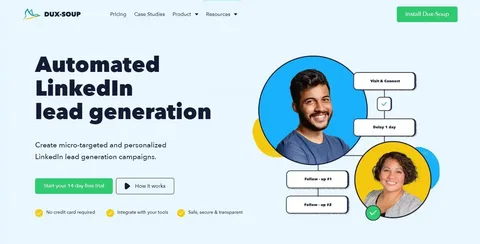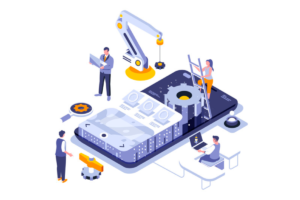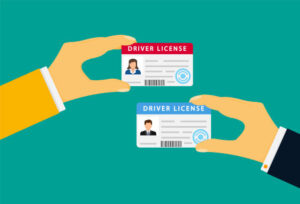How to Convert LinkedIn Connections into Loyal Customers
LinkedIn isn’t just a platform for growing your network—it’s a goldmine for converting connections into loyal customers. With over 930 million professionals actively engaging on the platform, LinkedIn has become the go-to hub for B2B lead generation, relationship-building, and sales.
However, simply adding connections isn’t enough. The real value lies in nurturing relationships and guiding your connections through a journey—from first contact to loyal customers. The secret? Consistent value, strategic engagement, and tools like a LinkedIn in prospecting tool for maketers to streamline and personalize outreach. In this guide, we’ll explore a step-by-step approach to turning LinkedIn connections into loyal customers, ensuring you maximize your ROI from every interaction.
1. Optimize Your LinkedIn Profile to Build Trust
Before you start converting connections into customers, make sure your LinkedIn profile is ready to impress. Your profile is often the first impression you make on potential customers, and a polished, value-driven profile can make all the difference.
Key Profile Elements to Focus On
- Headline: Go beyond your job title. Highlight how you help your target audience.
- Example: “Helping Marketers Streamline Outreach with LinkedIn Prospecting Tools | Generating Leads That Convert.”
- About Section: Share your story, expertise, and how you solve customer challenges. End with a call-to-action (CTA) that invites prospects to connect or message you.
- Professional Banner and Photo: Use visuals that represent your brand and services.
- Featured Section: Showcase content, case studies, or success stories that highlight your expertise.
An optimized profile builds credibility and ensures your connections take you seriously, increasing their likelihood of engaging with you.
2. Segment and Qualify Your LinkedIn Connections
Not every connection is a potential customer, and that’s okay. To convert connections into loyal customers, start by segmenting your audience.
How to Segment Your Connections
- Use LinkedIn Filters: Identify decision-makers based on job title, company size, and industry.
- Review Interactions: Identify connections who have engaged with your posts, viewed your profile, or replied to previous messages.
- Leverage a LinkedIn in prospecting tool for maketers: Tools like LiProspect allow you to automate outreach and manage leads effectively by segmenting your connections into targeted lists.
By qualifying your connections, you focus your efforts on those most likely to convert, saving time while improving results.
3. Engage Your Connections with Value-Driven Content
Once you’ve identified high-value connections, the next step is to engage them consistently with valuable content. LinkedIn is built for professional content sharing, and your ability to deliver insights that solve your audience’s challenges will determine their trust in you.
Types of Value-Driven Content That Work
Educational Posts: Share actionable tips, industry insights, and how-to content.
Example: “3 Ways LinkedIn Prospecting Tools Can Help Marketers Save Time and Improve Outreach Efficiency.”
Case Studies: Highlight success stories that show how you’ve helped similar businesses.
Polls and Questions: Spark engagement by asking questions related to your audience’s challenges.
Videos and Carousels: Share tutorials or step-by-step guides to showcase your expertise.
Content Tip: Add CTAs in your posts to guide readers to the next step—such as scheduling a call, downloading a resource, or sending you a message.
Engaging your audience with meaningful content builds trust and positions you as a valuable solution provider, making it easier to convert them into customers.
4. Send Personalized Messages to Build Relationships
After engaging connections with content, it’s time to start conversations. Personalized messaging is key to nurturing relationships on LinkedIn, but crafting messages manually for every lead can be overwhelming.
Best Practices for Personalized Messages
- Start with Their Name: Always use their name for a personal touch.
- Reference Mutual Interests: Mention shared groups, posts, or industry challenges.
- Offer Value First: Share insights, solutions, or resources that align with their pain points.
Example Personalized Message:
“Hi [First Name], I saw your post on challenges with B2B outreach—it really resonated with me. I help marketers streamline LinkedIn outreach using automation tools to save time and drive results. Would you be open to a quick chat to explore ideas?” A LinkedIn in prospecting tool for maketers like LiProspect can automate this process while maintaining personalization. By leveraging dynamic fields, you can send tailored messages to hundreds of leads, saving time while ensuring every connection feels valued.
5. Follow Up Strategically to Keep the Conversation Alive
Most prospects won’t respond to your first message. Consistent follow-ups are essential to stay top-of-mind and gently guide connections toward a decision.
How to Structure Follow-Up Sequences
First Follow-Up: Provide additional value, such as a case study, blog post, or free resource.
Example: “Hi [First Name], just following up! Here’s a quick case study showing how marketers used LinkedIn prospecting tools to boost response rates by 40%—thought you might find it helpful!”
Second Follow-Up: Ask a light question or invite them to a brief call.
Example: “Hi [First Name], I’d love to hear your thoughts on improving LinkedIn outreach. Do you have 15 minutes next week to share ideas?”
Final Nudge: Offer to connect at a later stage or leave the door open for future conversations.
Using a LinkedIn prospecting tool for marketers, you can schedule automated follow-up sequences to ensure consistent outreach while saving time.
6. Transition Conversations from LinkedIn to Offline Channels
LinkedIn is a powerful starting point, but converting leads into customers often requires taking the conversation offline. Once you’ve built rapport, guide your connections to a discovery call, virtual meeting, or demo.
How to Transition Smoothly
- Offer Clear Next Steps: Suggest a quick call to explore their challenges and discuss solutions.
- Example: “Hi [First Name], would you be open to a quick 15-minute call to discuss how we can help streamline your LinkedIn prospecting efforts?”
- Provide Value: Frame the call as an opportunity to share insights or solutions.
- Make It Easy: Share a scheduling link to simplify the process (e.g., Calendly).
By shifting to more personal interaction, you deepen relationships and increase the chances of converting leads into loyal customers
7. Use LinkedIn Prospecting Tools to Scale Your Efforts
Scaling personalized outreach can feel impossible without the right tools. A LinkedIn prospecting tool for marketers automates repetitive tasks like sending connection requests, follow-up messages, and tracking leads—while maintaining a human touch.
Benefits of LinkedIn Prospecting Tools
- Automated Outreach: Send personalized messages at scale to engage more leads without manual effort.
- Follow-Up Sequences: Schedule strategic follow-ups to nurture connections consistently.
- Advanced Targeting: Identify and filter leads based on job title, industry, company size, and more.
- Performance Tracking: Monitor responses, connection acceptance rates, and conversions to optimize your strategy.
Tools like LiProspect help marketers streamline their LinkedIn outreach, nurture connections effectively and ultimately convert them into paying customers.
. Nurture Relationships to Create Long-Term Loyalty
Converting a LinkedIn connection into a customer is only the beginning. To create loyal customers who advocate for your business, focus on long-term relationship-building.
Strategies for Building Loyalty
- Stay in Touch: Share relevant insights, updates, or valuable resources periodically.
- Offer Continued Support: Be proactive in helping clients solve new challenges.
- Engage with Their Content: Like, comment, and share posts to show genuine interest in their success.
- Request Feedback: Ask for input to improve your offerings and strengthen relationships.
By consistently nurturing relationships, you transform customers into loyal advocates who are more likely to refer others to your business.
Conclusion
LinkedIn is the ultimate platform for marketers and sales professionals to convert connections into loyal customers. By optimizing your profile, engaging with value-driven content, and leveraging tools like a LinkedIn in prospecting tool for maketers, you can scale personalized outreach, build trust, and drive meaningful relationships.
The key lies in delivering value at every touchpoint—whether through insightful content, thoughtful messaging, or consistent follow-ups. When you combine human connection with smart automation, LinkedIn becomes a powerful engine for generating loyal customers and sustainable growth. Are you ready to turn your LinkedIn connections into lasting business relationships? Start today and watch your network transform into a pipeline of loyal, high-value customers.
FAQs
1. What is a LinkedIn prospecting tool for marketers?
A LinkedIn prospecting tool automates connection requests, follow-ups, and outreach, helping marketers engage prospects at scale while maintaining personalization.
2. How can I personalize LinkedIn messages effectively?
Use the recipient’s name, reference shared interests or challenges, and offer value-driven solutions tailored to their role or industry.
3. Why are follow-ups important in LinkedIn outreach?
Follow-ups keep you top-of-mind and increase the chances of a response, as most leads require multiple touchpoints before engaging.
4. What content should I share to engage my LinkedIn connections?
Educational posts, case studies, videos, and polls that solve your audience’s challenges and showcase your expertise work best.
5. How can I automate LinkedIn outreach without losing the human touch?
Tools like LiProspect allow you to automate messaging while using dynamic fields to personalize outreach and build genuine relationships.
visit : freshvoicehub












Post Comment